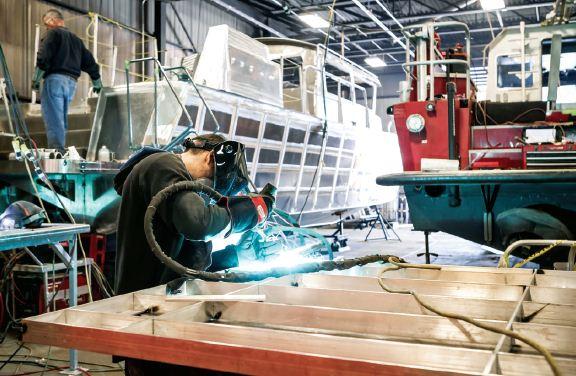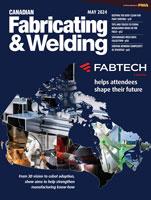- FMA
- The Fabricator
- FABTECH
- Canadian Metalworking
Arc regulation, modification and manipulation
A lot goes in to the welding arc each millisecond.
- By Nestor Gula
- May 20, 2015
- Article
- Welding
Welding is not just putting enough heat on some pieces of metal and having them fuse to each other. There are many elements to a proper weld. One of the essential requirements for a proper weld is to have a stable arc that shoots out of the wire and onto the part being welded. The better and more consistent the arc the higher quality the final weld will be.
“At the end of the day, it is about creating the best possible arc for the application,” says Caleb Haven, welding engineer, for Miller Electric Mfg. Co. “For example, the arc that I would want for handheld welding may be very different than the arc a robot operator would want for seam tracking or fast travel speeds. Especially for more advanced processes (Pulse/Accu-Pulse/RMD), it is about building enough flexibility into the process that it can be adapted for many applications.”
When modifying or regulating the arc, the main goal is to maintain a constant pre-set voltage when welding—the adjustments, “allow for variations in stick out, torch angle, etc.,” says Jim Shields, a welding engineer at Lincoln Electric. “We are trying to maintain a voltage. If we are trying to maintain 22 volts, if everything is constant then everything is fine. But if it is pulled longer or pushes shorter this changes the amount of energy needed, so you have to modify some of those parameters so we still have the same voltage.”
Most power sources have microcontrollers that will adjust the arc as needed. “Arc control begins with conditioning primary power, transforming and manipulating it so that it becomes optimized for welding. Virtually every power source does this to a lesser or greater degree, depending on its level of sophistication,” says Tom Wermert, senior brand manager for ESAB. “Our MICOR technology stores voltage and power so that the ArcMaster can provide a fast dynamic response to changing arc conditions,” he says.
“A simple analogy would be ensuring that your compressor tank always has enough air to meet the needs of an air tool, no matter how great or sudden the demand. In the case of the ArcMaster, it means that the system can do things to enhance arc stability and reduce spatter.”
Depending on the type of welding, the power source changes variables such as frequency, base current, and peak current, in an attempt to maintain the set voltage. “Let’s say you are trying to maintain 22 volts,” says Shields. He notes elements that can be modified include the background current, which is the current at the low level; the ramp break, which is how quickly it goes to the top, and then how long it stays at the top—what the current is at the top, and how quickly it comes down; and the frequency. “If you set 22 volts, the machine is always monitoring those parameters and then it will change those parameters to try and get those 22 volts that you are asking for.” This is manipulation of the frequency and amplitude and the duration at the high level, he explains. “Typically you are at the high current for two milliseconds, so maybe if you need more voltage you can stay at the high end for 2.2 milliseconds instead of 2. The main way to modify is the frequency and also the amplitude of both the background and the peak.”
Modern welding equipment monitors and regulates the arc many thousands of times per second in the background, constantly making tiny adjustments to the weld process ensuring a stable and consistent arc. “As far as arc regulation goes, there are really two aspects to consider,” says Haven. “One is the weld process control—usually a piece of software—that seeks to regulate the arc long term. For Pulse welding, this mostly relates to building and transferring the same size droplet across the arc with every pulse. The other aspect of arc regulation is how the process control responds to relatively short-lived events in the arc, such as shorting. For Pulse GMAW (MIG) and SMAW (Stick welding), the goal is to deal with these short-lived events in a way that preserves the stability of the process and generates the least amount of spatter.”
There are many different variables for regulating the welding processes. In pulse welding, a major component is regulating the frequency. “The frequency regulation in Pulse is often audible, a bumble bee-like sound in the arc. Some Pulse processes, like Accu-Pulse from Miller, use a fixed frequency and adjust other variables in the process,” says Haven. “The stability and spatter generation of a SMAW or GMAW arc are related to how well the process deals with shorts. We don’t often think of shorting events in these processes, but the dig function in SMAW and the inductance control of GMAW both adjust how the process clears shorts.”
The adjustment of the frequency of the pulse is based on a number of factors. “The system is telling the power source to ramp up at a certain speed, let’s say for example, 50 amps per millisecond,” says Shields. “Let’s say you want to go to 450 amps, so you are going up 400 amps from your background to your peak. Let’s just say you are going up 400 amps per millisecond, so it will take one milliseconds to go from 50 to 450 and once you get up there, you stay there for a certain amount of time, let’s say two milliseconds and then you have to come down at a certain rate. Your background is determined by your frequency rate—the higher the frequency the less time you are in the background.”

Spark control is essential for proper welding where high tolerances are required. PHOTO COURTESY OF LINCOLN ELECTRIC
One major aspect that affects the frequency is the wire feed speed. “Let’s say at a hundred inches a minute of wire feed speed you are running a 100 times a second, and if you are going to go to 200 inches a minute of wire feed speed you will go to about 125 times a second,” Shields explains. “If you want to go to 300 inches a minute you might have to go to 150 times a second. So the higher the wire feed speed is the faster your frequency. The higher the frequency the less time you spend at your background. Typically your background is longer than your peak.”
When it comes to the selection of material that is welded or the wire that will be used to weld it, a specific arc setting must be used. There is no one setting that works for all types of materials, wires and gases. “ESAB’s power source engineers worked hand-in-hand with the aluminum filler metal experts at AlcoTec, an ESAB company, during the development of the Aristo Mig 4004i Pulse power source, Aristo control panel and Aristo Feed 3004 feeder,” says Greg Stauffer, vice president, sales support and standard equipment for ESAB. “As a result, the system delivers superior aluminum welding performance, especially with the SuperPulse process, which provides a TIG-like bead appearance without gun manipulation.”
To this end ESAB designed synergic lines—pre-programmed welding procedures—to help the operator avoid globular regions between short arc and spray arc where the arc becomes unstable and large weld spatter is generated.
Most manufactures have similar systems built into their power sources. Many of the simpler welding systems have one arc characteristic for all wires or electrodes, says Haven. “The more advanced welding systems can offer many arc characteristics that have been customized for different filler metals, shielding gasses or welding applications. This can be as simple as an inductance setting for GMAW wire or as complex as a set of pulse data for the same wire.”
Depending on the sophistication of the machine, end users have many different controls to adjust welding arcs for their own applications. “GMAW processes typically have an inductance control and a voltage control. SMAW usually has a current and a dig adjustment. Pulse processes typically offer an arc length control and an arc control/sharp arc adjustment,” Haven says, adding “with the more advanced processes like Pulse, there is a whole list of underlying variables that determine the arc characteristic. These variables are typically set at the factory and not adjusted by end users.
“The arc length and arc control/sharp arc functions allow an end user a great deal of arc customization without having to understand the intricacies of building a Pulse waveform. Essentially, arc length and arc control/sharp arc adjust many of the underlying Pulse variables, but in a simple, easy-to-understand way,” explains Haven.
About the Author
subscribe now


Keep up to date with the latest news, events, and technology for all things metal from our pair of monthly magazines written specifically for Canadian manufacturers!
Start Your Free Subscription- Industry Events
Automate 2024
- May 6 - 9, 2024
- Chicago, IL
ANCA Open House
- May 7 - 8, 2024
- Wixom, MI
17th annual Joint Open House
- May 8 - 9, 2024
- Oakville and Mississauga, ON Canada
MME Saskatoon
- May 28, 2024
- Saskatoon, SK Canada
CME's Health & Safety Symposium for Manufacturers
- May 29, 2024
- Mississauga, ON Canada






















